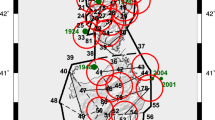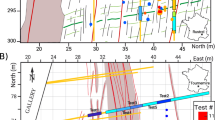Abstract
The M w 3.2-induced seismic event in 2006 due to fluid injection at the Basel geothermal site in Switzerland was the starting point for an ongoing discussion in Europe on the potential risk of hydraulic stimulation in general. In particular, further development of mitigation strategies of induced seismic events of economic concern became a hot topic in geosciences and geoengineering. Here, we present a workflow to assess the hazard of induced seismicity in terms of occurrence rate of induced seismic events. The workflow is called Forward Induced Seismic Hazard Assessment (FISHA) as it combines the results of forward hydromechanical-numerical models with methods of time-dependent probabilistic seismic hazard assessment. To exemplify FISHA, we use simulations of four different fluid injection types with various injection parameters, i.e. injection rate, duration and style of injection. The hydromechanical-numerical model applied in this study represents a geothermal reservoir with preexisting fractures where a routine of viscous fluid flow in porous media is implemented from which flow and pressure driven failures of rock matrix and preexisting fractures are simulated, and corresponding seismic moment magnitudes are computed. The resulting synthetic catalogues of induced seismicity, including event location, occurrence time and magnitude, are used to calibrate the magnitude completeness M c and the parameters a and b of the frequency-magnitude relation. These are used to estimate the time-dependent occurrence rate of induced seismic events for each fluid injection scenario. In contrast to other mitigation strategies that rely on real-time data or already obtained catalogues, we can perform various synthetic experiments with the same initial conditions. Thus, the advantage of FISHA is that it can quantify hazard from numerical experiments and recommend a priori a stimulation type that lowers the occurrence rate of induced seismic events. The FISHA workflow is rather general and not limited to the hydromechanical-numerical model used in this study and can therefore be applied to other fluid injection models.





Similar content being viewed by others
References
Altmann J, Müller T, Müller B, Tingay M, Heidbach O (2010) Poroelastic contribution to the reservoir stress path. Int J Rock Mech Min 47(7):1104–1113
Baisch S, Voros R, Rothert E, Stang H, Jung R, Schellschmidt R (2010) A numerical model for fluid injection induced seismicity at Soultz-sous-Forêts. Int J Rock Mech Min 47(3):405–413
Barth A, Wenzel F, Langenbruch C (2013) Probability of earthquake occurrence and magnitude estimation in the post shut-in phase of geothermal projects. J Seismol 17(1):5–11
Bommer JJ, Oates S, Cepeda JM, Lindholm C, Bird J, Torres R, Marroquin G, Rivas J (2006) Control of hazard due to seismicity induced by a hot fractured rock geothermal project. Eng Geol 83:287–306
Bruel D (2007) Using the migration of induced seismicity as a constraint for fractured hot dry rock reservoir modeling. Int J Rock Mech Min 44:1106–1117
Cornet FH, Bèrard Th, Bourouis S (2007) How close to failure is a granite rock mass at a 5 km depth? Int J Rock Mech Min 44(1):47–66
Deichmann N, Ernst J (2009) Earthquake focal mechanisms of the induced seismicity in 2006 and 2007 below Basel (Switzerland). Swiss J Geosci 102:457–466
Deichmann N, Giardini D (2009) Earthquakes induced by the stimulation of an enhanced geothermal system below Basel (Switzerland). Seismol Res Lett 80(5):784–798
Dieterich J (1994) A constitutive law for rate of earthquake production and its application to earthquake clustering. J Geophys Res 99(B2):2601–2618
Dinske C, Shapiro S (2013) Seismotectonic state of reservoirs inferred from magnitude distributions of fluid-induced seismicity. J Seismol 17(1):13–25
Evans KF, Zappone A, Kraft T, Deichmann N, Moia F (2012) A survey of the induced seismic response to fluid injection in geothermal and CO2 reservoirs in Europe. Geothermics 41:30–54
Grünthal G (2013) Induced seismicity related to geothermal projects versus natural tectonic earthquakes and other types of induced seismic events in central Europe. Geothermics. doi:10.1016/j.geothermics.2013.09.009
Gutenberg B, Richter CF (1956) Earthquake magnitude, intensity, energy and acceleration (second paper). Bull Seismol Soc Am 46(2):105–145
Hakimhashemi AH, Schoenball M, Heidbach O, Zang A, Grünthal G (2014) Forward modelling of seismicity rate changes in georeservoirs with a hybrid geomechanical-statistical prototype model. Geothermics. doi:10.1016/j.geothermics.2014.01.001
Häring MO, Schanz U, Ladner F, Dyer BC (2008) Characterisation of the Basel 1 enhanced geothermal system. Geothermics 37(5):469–495
Hazzard JF, Young RP (2002) Moment tensors and micromechanical models. Tectonophysics 356:181–197
Hazzard JF, Young RP (2004) Dynamic modelling of induced seismicity. Int J Rock Mech Min 41(8):1365–1376
Hubbert MK, Willis DG (1957) Mechanics of hydraulic fracturing. Trans AIME 210:153–166
Kohl T, Megel T (2007) Predictive modeling of reservoir response to hydraulic stimulations at the European EGS site Soultz-sous-Forets. Int J Rock Mech Min 44(8):1118–1131
Labuz JF, Zang A (2012) Mohr-Coulomb failure criterion. Rock Mech Rock Eng 45:975–979
Majer EL, Baria R, Stark M, Oates S, Bommer J, Smith B, Asanuma H (2007) Induced seismicity associated with enhanced geothermal systems. Geothermics 36:185–222
Majer E, Nelson J, Robertson-Tait A, Savy J, Wong I (2012) Protocol for addressing induced seismicity associated with enhanced geothermal systems. U.S. Department of Energy, DOE/EE-0662
Marzocchi W, Sandri L (2003) A review and new insights on the estimation of the b-value and its uncertainty. Annals of Geophysics 46(6):1271–1282
McClure MW, Horne HN (2011) Investigation of injection-induced seismicity using a coupled fluid flow and rate and state friction model. Geophysics 76(6):WC183–WC200
Nuannin P, Kulhanek O, Persson L (2005) Spatial and temporal b value anomalies preceding the devastating off coast of NW Sumatra earthquake of December 26, 2004. Geophys Res Lett 32(L11307)
Page R (1968) Aftershocks and microaftershocks of the Great Alaska earthquake of 1964. Bull Seismol Soc Am 58(3):1131–1168
Rutqvist J, Birkholzer J, Cappa F, Tsang C-F (2007) Estimating maximum sustainable injection pressure during geological sequestration of co2 using coupled fluid flow and geomechanical fault-slip analysis. Energy Conversion and Management 48:1798–1807
Schoenball M, Müller TM, Müller B, Heidbach O (2010) Fluid-induced microseismicity in pre-stressed rock masses. Geophys J Int 180:113–119
Shao J, Tu D (1995) The jackknife and bootstrap. Springer Series in Statistics
Shapiro S, Dinske C, Langenbruch C, Wenzel F (2010) Seismogenic index and magnitude probability of earthquakes induced during reservoir fluid stimulations. Leading Edge 29(3):304–309
Stigler SM (2007) The epic story of maximum likelihood. Statistical Science 22(4):598–620
Suckale J (2009) Induced seismicity in hydrocarbon fields. Adv Geophys 51:55–106
Suckale J (2010) Moderate-to-large seismicity induced hydrocarbon production. The Leading Edge 310–317
Yoon JS, Zang A, Stephansson O (2013) Simulation of hydraulic stimulation of fractured reservoir and induced seismicity using discrete element-fracture network model. Proceedings of Thirty-Eighth Workshop on Geothermal Reservoir Engineering, Stanford University, Stanford, California, February 11–13, 2013, SGP-TR-198
Yoon JS, Zang A, Stephansson O (2014) Numerical investigation of optimized stimulation of intact and naturally fracture deep geothermal reservoirs using hydro-mechanical coupled discrete particles joints model. Geothermics. doi:10.1016/j.geothermics.2014.01.009
Zang A, Yoon JS, Stephansson O, Heidbach O (2013) Fatigue hydraulic fracturing by cyclic reservoir treatment enhances permeability and reduces induced seismicity. Geophys J Int 195:1282–1287
Acknowledgments
The work presented was funded by the European Commission within the FP7 project GEISER, grant agreement no. 241321, by the Department of Energy Geothermal Technologies Program under Award Number DE-EE0002756-002 as well as by AonBenfield, London. We appreciate the comments from two anonymous reviewers.
Author information
Authors and Affiliations
Corresponding author
Rights and permissions
About this article
Cite this article
Hakimhashemi, A.H., Yoon, J.S., Heidbach, O. et al. Forward induced seismic hazard assessment: application to a synthetic seismicity catalogue from hydraulic stimulation modelling. J Seismol 18, 671–680 (2014). https://doi.org/10.1007/s10950-014-9439-y
Received:
Accepted:
Published:
Issue Date:
DOI: https://doi.org/10.1007/s10950-014-9439-y




